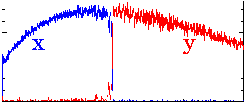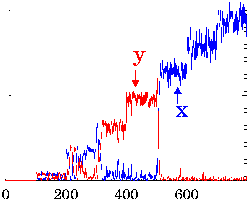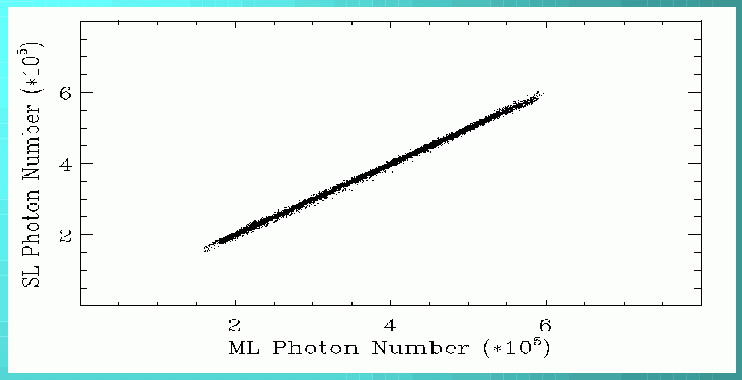


|
|
|
|
|
In this line of research we make theoretical, computational and experimental studies of active semiconductor optical devices (semiconductor lasers and optical amplifiers). We focus our activity on the nonlinear dynamics of these devices, as well as on the processes of selection, formation and dynamics of intensity and/or polarization patterns of the optical field, and on the response to modulation, optical injection and optical feedback.
| SEMICONDUCTOR LASERS WITH FEEDBACK |
Semiconductor lasers exhibit a large sensitivity to optical feedback. Under adequate conditions it reduces the laser linewidth, but it also leads to unstable emission and, for large feedback, to the collapse of the laser coherence. Despite the importance of this phenomenon in many applications and many current studies, the physical mechanisms underlying the phenomenon are controversial.
Fig.1: Time resolved spectrum of an edge emitting laser in the LFF regime (time ns vs wave lenght) 
Fig.2: Optical power emitted by a VCSEL in each polarization mode in the LFF regime. Upper figure are experimental observations. Lower figure are theoretical results (red and orange lines)
| We have experimentally demonstrated (Fig. 1) that in the regime of Low Frequency Fluctuations (LFF) the longitudinal modes of the laser try to keep antiphase dynamics, but they synchronize just before every drop out of the intensity, giving evidence of the need for a multimodal description of the phenomenon. (G. Vaschenko, M. Giudici, J. J. Rocca, C. S. Menoni, J. Tredicce and S. Balle, Phys. Rev. Lett. 81 5536 (1998)). For small area VCSELs there is a single mode with two possible polarizations. We have shown experimentally that for a VCSEL with moderate feedback in the LFF regime of the total optical power, the two polarizations exhibit antiphase dynamics. The power drop-out of the dominant polarization is synchronized with the power increase of the depressed polarization (Fig.2). (M. Giudici, T. Ackemann, S. Barland, J. R. Tredicce and S. Balle, J. Opt. Soc. Am. B 16,2114 (1999)) |
|
|
Semiconductor optical amplifiers (SOA) are very attractive devices because of their intrinsic nonlinearities for applications in systems using wavelength division multiplexing. Potential uses are wavelength conversion, ultrafast codification and all-optical clock signal extraction. However, there was no useful modeling of these devices available accounting for wavelength dependence of gain and refraction index.
Distributions of optical power (above) and carrier density (below) for two identical SOA, except for different gain factors, operating at the same equal maximum gain. Using our previous mesoscopic modeling of the optical susceptibility of active semiconductor media which takes into account the wavelength dependence of the response we have studied the characteristics of the output beam of a tapered SOA for high power applications. Our modeling predicts, in agreement with experimental observations, that in a SOA with larger optical confinement, the advantage of requiring a smaller injection current, for a fixed amplifying factor, is compensated by a larger tendency to filamentation of the output beam, as well as for a smaller saturating power of the device.
A. Gahl and S. Balle, IEEE Photon. Technol. Lett. 11, 1375 (1999).
|
|
Vertical Cavity Surface Emitting Lasers (VCSELs) are very useful devices for a number of applications in information technologies, such as optical interconnects. A problem for many other possible applications is their lack of polarization stability. They exhibit polarization switching (PS) between two preferred directions as the injection current is changed. Understanding the physical mechanisms of these phenomenon can improve strategies of polarization control and the use of polarization for information processing.

Fig. 1: Transverse profile of each polarization of the VCSEL beam through a polarization switching. Current increases from left to right 

Fig. 2: Time traces of a polarization switch (time scale in ns). The upper panel corresponds to a thermally induced PS with characteristic thermal roll over. Lower panel corresponds to a non-thermal PS from the red to the blue side of the spectrum
We have a developed a mesoscopic model for the polarization nonlinear dynamics of VCSELs emitting in the fundamental transverse mode. It goes beyond normal rate equations or two-level approaches and it incorporates a semiconductor complex susceptibility with frequency dependent gain and index of refraction. This model reconciles the two mechanisms proposed in the literature for polarization switching (PS). One based on thermal effects and gain differences, and another, proposed by ourselves (SFM model) and based on saturable dispersion and spin carrier dynamics. The two preferred polarizations are frequency splitted. The first mechanism predicts PS from the blue to the red side of the spectrum as the injection current increases. The second mechanism allows for PS from the red side to the blue side. Both types of polarization switching have been experimentally observed and are described in our mesoscopic approach (Fig. 2). (S. Balle, E. Tolkachova, M. San Miguel, J. Tredicce, J. Martín-Regalado, and A. Gahl, Optics Letters 24, 1121 (1999)).
|
APPLICATION TO ENCODED COMMUNICATIONS |
The essence of the optical communication using chaotic carriers resides in the fact that two spatially-separated chaotic semiconductor lasers can synchronize to each other. Synchronization means that the irregular time evolution of the emitter laser can be perfectly reproduced by the receiver laser. Once the two lasers have been synchronized, we can use the chaotic output of the emitter laser as the carrier on which the message is encoded. The other laser, in the receiver system, allows the message to be extracted. The key issue resides in the fact that the receiver synchronizes to the chaotic oscillations of the emitter (the carrier), however, suppressing the encoded message. Therefore, by comparing the input (carrier + message) and output (carrier only) of the receiver, the message can be extracted.

|
| We have numerically studied the synchronization of two chaotic external
cavity semiconductor lasers in a master-slave configuration following our
previous proposals (C. Mirasso, P. Colet and P. García-Fernández,
IEEE, Phot. Tech. Lett. 8, 299 (1996)). We have obtained synchronization
when a minimum value for the coupling between the lasers is reached, even
when the lasers are not identical. We observe that the synchronization
quality degrades with the noise, with the detuning between the lasers and
other laser parameters. The most critical parameter seems to be the detuning,
although a good synchronization diagram can be continuously obtained for
a detuning range of tens of GHz. Digital messages modulated at frequencies
up to 4 Gbit/s can be encoded in the chaotic signal of the master laser
and recovered at the SL. The fluctuations that appear in the recovered
message can be reduced by a simple filtering process.
A. Sanchez, C. Mirasso, P. Colet and P. García-Fernández, IEEE, J. Quantum Electronics 35, 292 (1999)). |
|
|
|